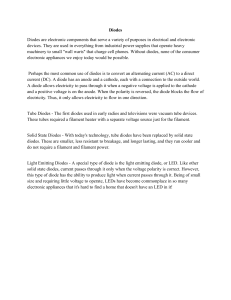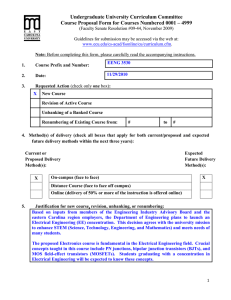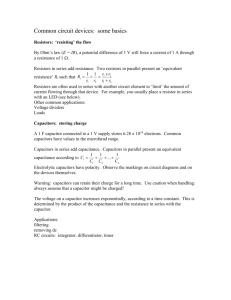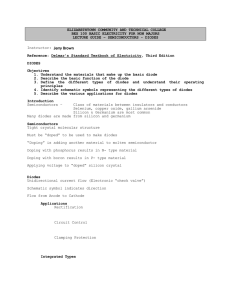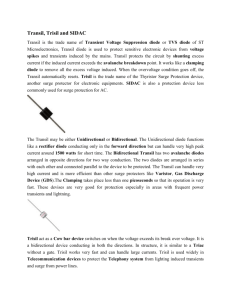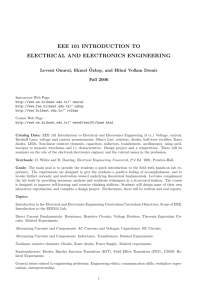Diodes and Transistors
advertisement
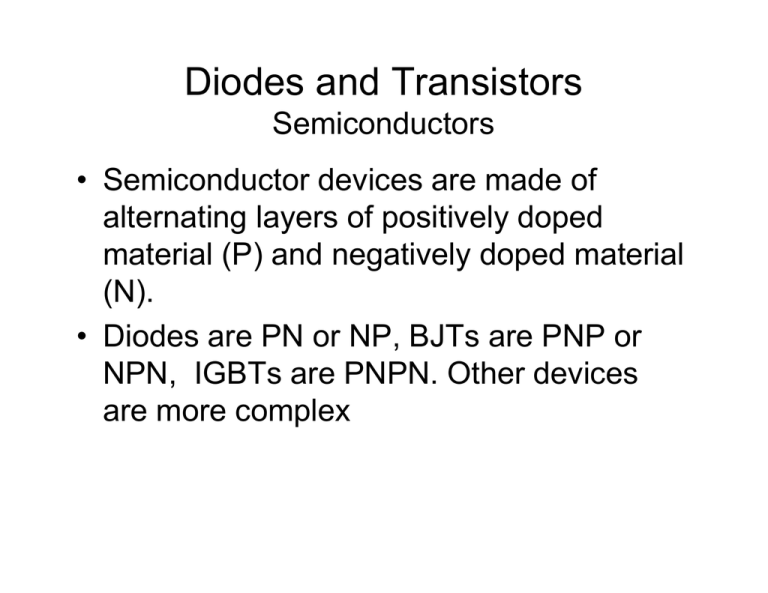
Diodes and Transistors Semiconductors • Semiconductor devices are made of alternating layers of positively doped material (P) and negatively doped material (N). • Diodes are PN or NP, BJTs are PNP or NPN, IGBTs are PNPN. Other devices are more complex Diodes • A diode is a device which allows flow in one direction but not the other. • When conducting, the diodes create a voltage drop, kind of acting like a resistor • There are three main types of power diodes – Power Diode – Fast recovery diode – Schottky Diodes Power Diodes • Max properties: 1500V, 400A, 1kHz • Forward voltage drop of 0.7 V when on Diode circuit voltage measurements: (a) Forward biased. (b) Reverse biased. Fast Recovery Diodes • Max properties: similar to regular power diodes but recover time as low as 50ns • The following is a graph of a diode’s recovery time. trr is shorter for fast recovery diodes Schottky Diodes • Max properties: 400V, 400A • Very fast recovery time • Lower voltage drop when conducting than regular diodes • Ideal for high current low voltage applications Current vs Voltage Characteristics • All diodes have two main weaknesses – Leakage current when the diode is off. This is power loss – Voltage drop when the diode is conducting. This is directly converted to heat, i.e. power loss • Other problems to watch for: – Notice the reverse current in the recovery time graph. This can be limited through certain circuits. Ways Around Maximum Properties • To overcome maximum voltage, we can use the diodes in series. Here is a voltage sharing circuit • To overcome maximum current, we can use the diodes in parallel. Here is a current sharing circuit • More information http://users.ece.gatech.edu/mleach/ece3050/notes/diode/diode.pdf Transistors • Types of Transistors – BJT – Bipolar Junction Transistors – IGBT – Insulated-Gate Bipolar Transistor – MOSFET – Metal-Oxide Semiconductor Field Effect Transistor – COOLMOS - proprietary name – SIT – Static Induction Transistor BJT • There are two types of BJTs. PNP and NPN. NPN are most common • BJTs are current controlled devices. Putting current into the gate will allow current to flow from the collector to the emitter. • When operating as a switch, the BJT operates deep in the saturation region (with base current really really high) • When operating as an amplifier the BJT works in the active region • Like diodes, they have a voltage drop when conducting but it is very low • More info – http://www.gyte.edu.tr/dosya/102/dersler /ELM%20629/Ch21.pdf Voltage and Current Characteristics of a BJT PNP (left) NPN (right) MOSFET and COOLMOS • Advantages of MOSFET – Voltage controlled device (Voltage at the gate will make current flow. Very small input current required, less power loss) – No second breakdown – High speed • Disadvantages of MOSFET – High voltage drop when conducting – Can only support low power compared to BJT • Two main types of MOSFETS – Enhancement type (Normally off), Depletion type (Normally on) • COOLMOS is a better version of a MOSFET because it has much lower voltage drop when conducting but it has lower power capabilities so it’s uses are limited. MOSFET and COOLMOS cont’d MOSFET IGBT • A cross between BJT and MOSFET – Low voltage drop when conducting (like BJT) – Voltage controlled (like MOSFET) • IGBTs are used under 20kHz • IGBT vs. MOSFET – http://www.irf.com/technicalinfo/whitepaper/choosewisely.pdf Voltage and Current Characteristics of an IGBT Table of Transistors and their Applications How to Overcome Transistor Limits • Like diodes, use them in series to increase voltage capacity and parallel to increase current capacity. Timing is CRUCIAL. If one turns on or off first it will take all the current or voltage and break!

